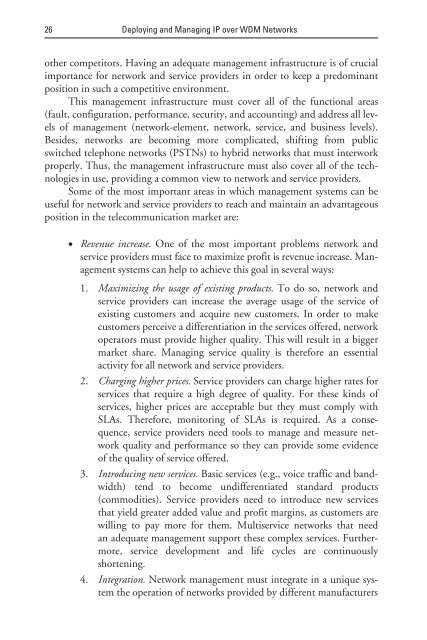deploying and managing ip over wdm networks - Index of
deploying and managing ip over wdm networks - Index of
deploying and managing ip over wdm networks - Index of
Create successful ePaper yourself
Turn your PDF publications into a flip-book with our unique Google optimized e-Paper software.
26 Deploying <strong>and</strong> Managing IP <strong>over</strong> WDM Networks<br />
other competitors. Having an adequate management infrastructure is <strong>of</strong> crucial<br />
importance for network <strong>and</strong> service providers in order to keep a predominant<br />
position in such a competitive environment.<br />
This management infrastructure must c<strong>over</strong> all <strong>of</strong> the functional areas<br />
(fault, configuration, performance, security, <strong>and</strong> accounting) <strong>and</strong> address all levels<br />
<strong>of</strong> management (network-element, network, service, <strong>and</strong> business levels).<br />
Besides, <strong>networks</strong> are becoming more complicated, shifting from public<br />
switched telephone <strong>networks</strong> (PSTNs) to hybrid <strong>networks</strong> that must interwork<br />
properly. Thus, the management infrastructure must also c<strong>over</strong> all <strong>of</strong> the technologies<br />
in use, providing a common view to network <strong>and</strong> service providers.<br />
Some <strong>of</strong> the most important areas in which management systems can be<br />
useful for network <strong>and</strong> service providers to reach <strong>and</strong> maintain an advantageous<br />
position in the telecommunication market are:<br />
• Revenue increase. One <strong>of</strong> the most important problems network <strong>and</strong><br />
service providers must face to maximize pr<strong>of</strong>it is revenue increase. Management<br />
systems can help to achieve this goal in several ways:<br />
1. Maximizing the usage <strong>of</strong> existing products. To do so, network <strong>and</strong><br />
service providers can increase the average usage <strong>of</strong> the service <strong>of</strong><br />
existing customers <strong>and</strong> acquire new customers. In order to make<br />
customers perceive a differentiation in the services <strong>of</strong>fered, network<br />
operators must provide higher quality. This will result in a bigger<br />
market share. Managing service quality is therefore an essential<br />
activity for all network <strong>and</strong> service providers.<br />
2. Charging higher prices. Service providers can charge higher rates for<br />
services that require a high degree <strong>of</strong> quality. For these kinds <strong>of</strong><br />
services, higher prices are acceptable but they must comply with<br />
SLAs. Therefore, monitoring <strong>of</strong> SLAs is required. As a consequence,<br />
service providers need tools to manage <strong>and</strong> measure network<br />
quality <strong>and</strong> performance so they can provide some evidence<br />
<strong>of</strong> the quality <strong>of</strong> service <strong>of</strong>fered.<br />
3. Introducing new services. Basic services (e.g., voice traffic <strong>and</strong> b<strong>and</strong>width)<br />
tend to become undifferentiated st<strong>and</strong>ard products<br />
4.<br />
(commodities). Service providers need to introduce new services<br />
that yield greater added value <strong>and</strong> pr<strong>of</strong>it margins, as customers are<br />
willing to pay more for them. Multiservice <strong>networks</strong> that need<br />
an adequate management support these complex services. Furthermore,<br />
service development <strong>and</strong> life cycles are continuously<br />
shortening.<br />
Integration. Network management must integrate in a unique system<br />
the operation <strong>of</strong> <strong>networks</strong> provided by different manufacturers


